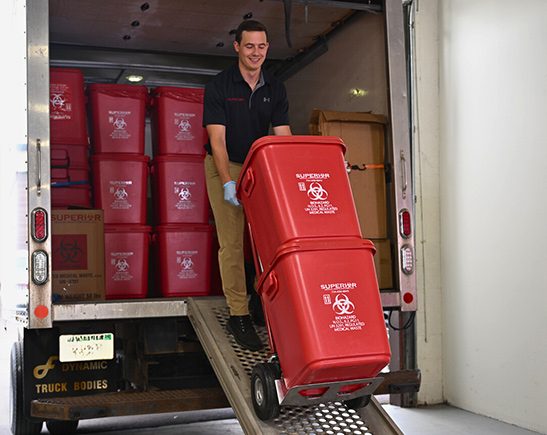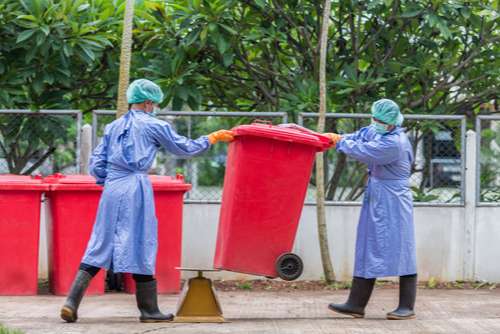Medical Waste Removal Proficiency: Where Service Excellence Satisfies Health Criteria
Medical Waste Removal Proficiency: Where Service Excellence Satisfies Health Criteria
Blog Article
The Importance of Correct Medical Garbage Disposal: A Guide for Health Care Facilities
Appropriate medical waste disposal is a critical facet of healthcare facility management, guaranteeing the security and well-being of individuals, team, and the setting. From recognizing the various categories of clinical waste to abiding with regulative needs, health care facilities should embrace efficient waste partition methods and pick ideal disposal approaches.
Recognizing Clinical Waste Categories
Comprehending clinical waste classifications is essential for appropriate disposal in health care facilities. Clinical waste is a wide term that encompasses various sorts of waste produced in health care settings, such as healthcare facilities, facilities, and research laboratories. Categorizing clinical waste aids make certain that it is taken care of, kept, and disposed of safely and based on appropriate policies.
There are a number of classifications of clinical waste that healthcare centers need to be aware of. These categories consist of transmittable waste, sharps waste, pharmaceutical waste, chemical waste, and contaminated waste (medical waste disposal services with WasteX). Each classification has specific features and calls for different disposal techniques to minimize the risk of damage to medical care workers, individuals, and the setting
Transmittable waste, as an example, describes throw away infected with possibly infectious products, such as blood, body fluids, and tissues. Sharps waste consists of needles, syringes, and various other sharp objects that can cause injury or send infections. Pharmaceutical waste is composed of run out or unused medicines, while chemical waste includes unsafe chemicals used in medical procedures. Finally, contaminated waste consists of materials polluted with contaminated substances, such as nuclear medicine products.
Compliance With Regulatory Requirements
Medical care facilities must make sure compliance with governing demands for proper clinical garbage disposal. Regulative bodies, such as the Epa (EPA) and the Occupational Security and Wellness Administration (OSHA), have established standards and laws to guard public wellness and the setting. These policies outline the proper handling, storage space, transportation, and disposal of clinical waste.
Conformity with regulatory demands is important for healthcare centers to prevent lawful charges, reputational damages, and prospective injury to human health and wellness and the environment. Failing to adhere to these regulations can cause penalties, claims, and even the suspension or abrogation of running licenses.
To make sure compliance, health care centers should develop comprehensive waste administration programs that consist of staff training, appropriate waste partition, and using suitable containers and labels. Normal audits and evaluations need to likewise be carried out to recognize any type of non-compliance problems and resolve them immediately.
It is necessary for healthcare facilities to stay up to date with modifications in laws and update their waste management methods appropriately. This can be achieved by proactively checking updates from governing bodies and taking part in training programs and workshops.
Executing Reliable Waste Segregation Practices
To ensure appropriate medical garbage disposal, medical care centers need to implement effective waste segregation practices. Waste segregation is an important action in the total waste management procedure, as it aids decrease the threat of infection, avoids cross-contamination, and makes sure the secure disposal of various sorts of waste. Efficient waste segregation practices involve dividing clinical waste into different categories based on its features and possible risks.
One typical method is the segregation of sharps waste, such as scalpels and needles, from other sorts of medical waste. Sharps waste should be put in puncture-resistant containers to avoid injuries and potential infections. Furthermore, dangerous waste, such as chemicals and pharmaceuticals, need to be separated from basic clinical waste to avoid ecological contamination.
Correct labeling and color-coding of waste containers are essential for effective waste partition. Clear and noticeable labels should be placed on each container to indicate the kind of waste it includes and any kind of special handling needs - medical waste disposal services with WasteX. Additionally, color-coding can be made use of to differentiate between different waste categories, making it simpler for medical care staff to determine and dispose of waste properly
Regular training and education for health care team is critical for the successful application of waste partition techniques. Employee need to be educated on the various waste classifications, appropriate partition methods, and the significance of complying with waste administration methods. This will certainly help guarantee compliance and consistency in waste partition techniques throughout the center.
Choosing Appropriate Disposal Methods
Appropriate choice of proper disposal approaches is essential in making sure the environmentally accountable and risk-free administration of medical waste in healthcare facilities. Healthcare centers create a range of medical waste, consisting of sharps, transmittable waste, pharmaceutical waste, and chemical waste - medical waste removal. Each kind of waste calls for certain disposal methods to reduce the danger of contamination, injury, and environmental harm
One common disposal approach for clinical waste is incineration. Incineration entails the controlled burning of waste at heats. This method works in ruining pathogens and reducing the quantity of waste. It can release hazardous pollutants medical waste disposal services with WasteX right into the air if not appropriately managed.

Chemical sanitation is one more method utilized for sure kinds of clinical waste, such as pharmaceutical waste. This method makes use of chemicals to counteract or ruin contaminants. Nonetheless, it is very important to select chemicals that are environmentally pleasant and safe.
In some cases, garbage dump disposal might appropriate for non-hazardous medical waste (medical waste disposal services with WasteX). However, proper segregation and packaging are important to stop leakage or contamination.
Ultimately, medical care facilities have to very carefully examine the characteristics of their medical waste and pick appropriate disposal methods that prioritize safety, environmental management, and governing compliance. Regular training and monitoring are necessary to ensure that health care team complies with proper disposal protocols.

Training and Educating Personnel on Appropriate Disposal Treatments
Personnel education and training play a crucial function in ensuring the proper disposal of medical waste in medical care centers. It is necessary that all employee, including medical professionals, nurses, specialists, and assistance team, get thorough training on correct disposal procedures. This training needs to cover the different sorts of medical waste, their potential dangers, and the appropriate methods for handling, setting apart, and disposing of them.
Among the main goals of staff education and training is to make certain that all medical care professionals comprehend the relevance of proper disposal treatments and the prospective consequences of inappropriate waste management. They require to be familiar with the threats linked with clinical waste, such as the transmission of infections and the contamination of the environment. medical waste removal near me. By recognizing these dangers, employee will be extra determined to adhere to proper disposal protocols and take the essential precautions to secure themselves, their colleagues, and the community
Educating need to likewise cover making use of personal protective devices (PPE) and the appropriate techniques for managing clinical waste. Team member ought to be enlightened on just how to identify and set apart various types of waste, such as sharps, transmittable waste, and unsafe chemicals. They ought to also be trained on the appropriate use waste containers, such as sharps containers and biohazard bags, along with the value of labeling and securing these containers correctly.
Moreover, personnel education and learning and training should consist of normal updates and refresher course programs to ensure that healthcare professionals stay notified concerning the current regulations and finest methods in medical garbage disposal. This recurring education and learning is critical to preserve a high level of understanding and conformity among employee.
Final Thought
Finally, appropriate medical garbage disposal is of utmost value for medical care facilities. Recognizing the various groups of medical waste and adhering to governing needs ensures the safety and health of both medical care workers and the public. Executing efficient waste partition practices and picking appropriate disposal approaches are crucial in protecting against the spread of infectious conditions and Learn More Here securing the atmosphere. Training and educating staff on appropriate disposal treatments is essential for preserving a clean and safe healthcare center.
From medical waste disposal services with WasteX recognizing the different groups of clinical waste to conforming with governing requirements, health care centers need to adopt efficient waste segregation techniques and select appropriate disposal approaches. These categories consist of transmittable waste, sharps waste, pharmaceutical waste, chemical waste, and radioactive waste.To ensure correct clinical waste disposal, medical care facilities must apply reliable waste partition methods. Waste partition is a crucial step in the total waste management process, as it aids minimize the danger of infection, avoids cross-contamination, and guarantees the risk-free disposal of various kinds of waste. Medical care facilities produce a selection of clinical waste, including sharps, infectious waste, pharmaceutical waste, and chemical waste.
Report this page